 When do your customers convert? Test Different Attribution Models To Figure Out What Marketing Channels Are Contributing to Conversions
When do your customers convert? Test Different Attribution Models To Figure Out What Marketing Channels Are Contributing to Conversions
Last year, over one million advertisers spent more than $81.5 billion on search ads worldwide. For many enterprises, SEM is a strategically important discipline. Many companies are investing in paid media advertising, (Adwords, display, social ads, email etc ) to increase downloads, signups, sales, leads and customer acquisitions. Consumers inhabit a digital omni-channel age where people are using their smartphones, tablets and laptops to research, compare and make purchase decisions. They also are consuming digital content at a greater velocity, and thru different mediums, and coupled with their rapid adoption of technology consumers are becoming ever more elusive to a “find and acquire mentality.”
A large part of marketing is knowing which campaigns are most effective—not only does this inform you where you should focus your resources to acquire new customers, but also this allows you to reasonably plan and project future growth.
For the better half of the 1900’s, marketing and advertising lacked the measurability that allowed campaign managers to effectively determine ROI: “Half the money I spend on advertising is wasted; the trouble is I don’t know which half.” – John Wanamaker, early 1900s department-store magnate
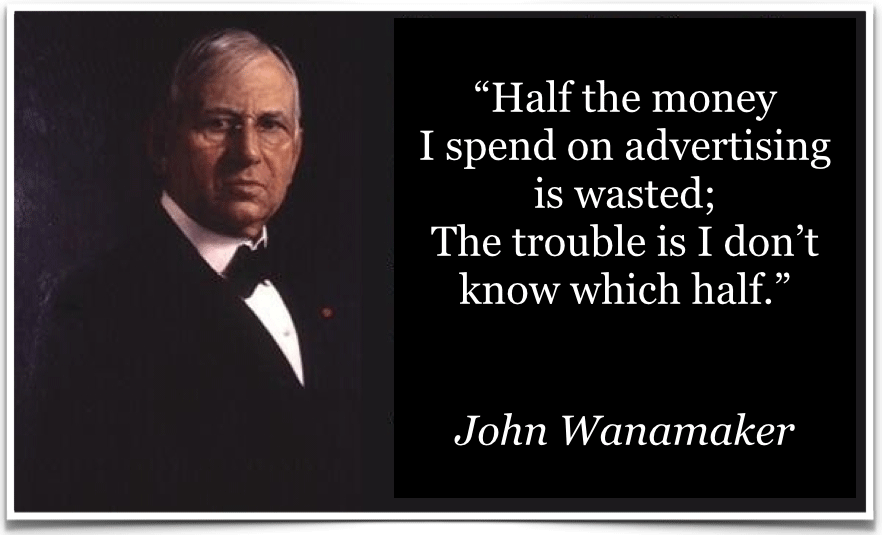
What is Attribution Modeling in Marketing?
Short answer: it’s the analytics method of determining what marketing channels, ads, sources, keywords, and tactics are driving or contributing the most to your website’s conversions.

If your customers aren’t getting a seamless experience across mobile devices, apps, web, and other channels, you’re likely losing them. What you need is a single solution that lets you connect the dots across devices and between online and physical experiences.
This means any previous messaging users were exposed to, in addition to any content they consumed that discussed your brand, isn’t appropriately accounted or credited for. If you are running multiple campaigns in today’s multi-device world, it can be tricky to measure ROI for each. How much influence did the Twitter ad impression make in this sign-up? How about the branded Adwords campaign? If most of your conversions come from paid search, should you still continue to invest in paid social? Building and applying attribution models to your data that take into account all consumer touchpoints, not just the first or last one can be very useful. Once you start to have a better understanding of how your customers are interacting with your ads and different marketing channels, then you can learn to optimize and choose how much credit each click should get for your conversions.
In this article you will learn:
- How attribution is critical to your marketing measurement.
- What better measurement can do for your company.
- How to use Data-Driven Attribution to build your company’s online marketing strategy.
Here are some of my recommendations and paid search attribution modeling analytics best practices.
1) Determine how important going beyond last-click attribution is to your business
As I mentioned earlier, the customer journey can be complex, not only across channels but also devices. Being able to identify which ad campaigns and marketing channels that actually influenced someone’s purchasing decision can be challenging for brands and marketers, but it’s very important to a get grasp and better understanding of which marketing channels are working and which ones are not with assisting conversions.
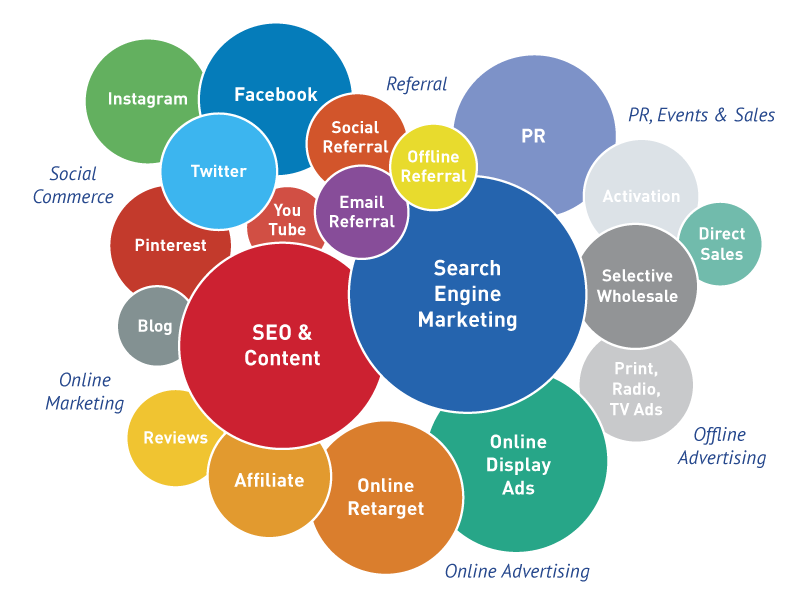
For instance, in Google Adwords, the default attribution option is to give or assign all credit for a conversion to the final ad click, which is called last-click attribution. Which does not account how many clicks came before, which it then gives all the credit to the final step in the process – like the sign hanging in the retail store window. And maybe that final click was the most important step, but maybe was only closing the deal from previous interactions the consumer had with your brand’s marketing efforts.
As an example, say a customer visits your site 5 times in a month before making a $100 purchase on your site. He may have first come to your site by clicking on a search ad, then by a retargeted social ad, then maybe he conducts a direct search to your site, and then finally a display banner ad brings him back and he finally makes a purchase. This is why sometimes going beyond the last click attribution for your paid search campaigns, can help you to understand your customer’s journey and make adjustments to improve your ads. If you pick the right model and set the right bids against it, you will be able to ultimately get more clicks that influence customers on their journey. The main idea is to drive a higher volume of profitable conversions. People can take awhile to make decisions; by changing to attribution modeling, you can identify how your advertising affects users across all of their crucial, decision making touch points or moments.
Depending on your industry and type of business, your marketing campaigns might be fairly straightforward. As an example, think of a local contractor business whose entire marketing strategy consists of being known in their town as a reliable service provider. If your Google Adwords paid SEM account, is simple enough to be the online equivalent of that (what if you are just bidding mostly on branded terms only), then evaluating and updating your attribution model may not be as so important.
Conclusion: If your paths to purchase are direct enough, the default last-click approach may be the right choice.
Assessing how Important Going Beyond The Last Model is For Your Business
The biggest benefit to getting attribution right: is growing your business by investing your marketing budgets in the right places at critical points in the buying journey or sales cycle.
If your conversion paths a short, though, you might already be investing in those crucial places with last-click measurement.
If you imagine the last time you made a purchase, it likely involved more than just one visit to a website. Think about the research or the browsing period of your purchase leading up to your decision to buy. Shouldn’t those channels get some of the credit?
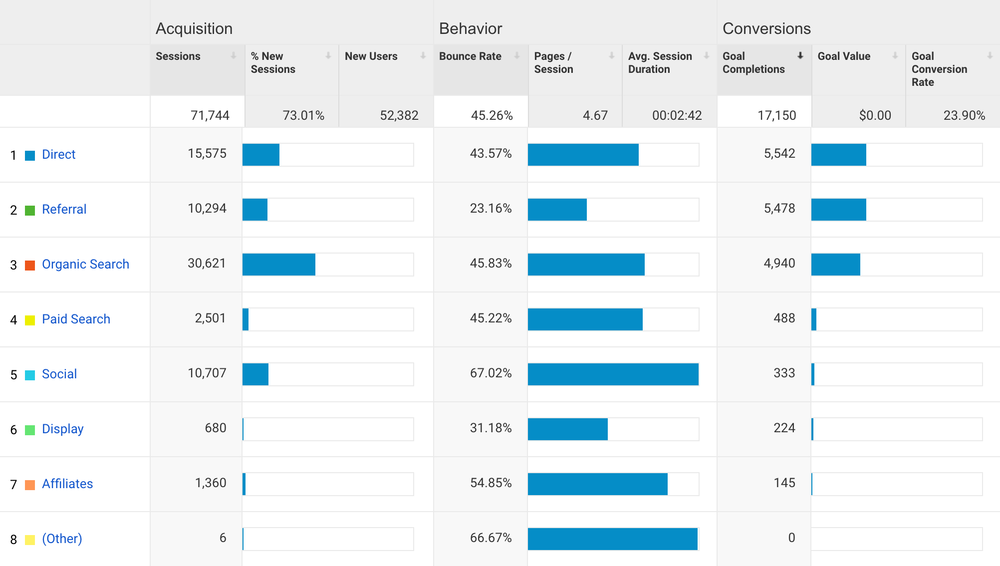
Last click: Gives all credit for the conversion to the last-clicked ad and corresponding keyword.
First click: Gives all credit for the conversion to the first-clicked ad and corresponding keyword.
Linear: Distributes the credit for the conversion equally across all clicks on the path.
Time decay: Gives more credit to clicks that happened closer in time to the conversion. Credit is distributed using a 7-day half-life. In other words, a click 8 days before a conversion gets half as much credit as a click 1 day before a conversion.
Position-based: Gives 40% of the credit to both the first- and last-clicked ads and corresponding keyword, with the remaining 20% spread out across the other clicks on the path.
Data-driven: Distributes credit for the conversion based on past data for this conversion action. (This is only available to accounts with enough data.)
Remember on the path to a conversion, a customer may do multiple searches and interact with multiple ads from the same advertiser.
It is recommended that you should review the Time Lag Report and specifically look at “days to conversion” and “hours to conversion”, which can help to give insights into users’ behavior. Depending on the length of your typical conversion path, you may be able to get a better sense of which attribution model will be most useful to your brand. Another report that should be viewed is the Path length Report, which instead of measuring time to conversion, it will show you the clicks on the path to conversion.
If you are running a limited keyword set you may not see a long time lag or path length.
The rest of guide will be covering the implications of going beyond last-click attribution and how to decide if non-last-click attribution is right for your brand.
2) Choose an attribution model that best fits your needs
There a number of different types of attribution models available for marketers to use with paid search campaigns. Vab Media can help you choose a model that best fits your company’s needs. A car company with a large budget might value introducing people to their latest vehicle and brand, while a coworking software app may care immensely about every ad interaction on the journey. The point is you will want to choose a model that best fits your brand’s marketing efforts and goals.
Tip: Whenever you start the process of picking a new attribution model, it’s advised to test how that model matches your approach to Adwords PPC campaigns. You want to see if it drives more conversions or value and then decide if this model correctly covers the path of your customer’s journey interacting with your brand.
If you have enough conversions to qualify, you could consider using a data-driven attribution (DDA)
Choosing the right attribution model can an important decision, and sometimes it can be best to let the numbers do the talking. This is where a data-driven attribution can be useful to your campaign analysis. A data-driven approach takes the guesswork out of choosing a model.
Depending on how large your monthly ad spend account is, if you have enough information (traffic), Google Analytics Premium services DoubleClick, Analytics 360 and Attribution 360 offer the use of data-driven attribution in which can help to paint the clearest possible picture of conversion success in your account. There is also other third-party (non-Google) analytics software such as Adinton, Convertro, and Kissmetrics that offer multi-touch attribution insight solutions as well.
 How the Data-Driven Attribution (DDA) Methodology Works
How the Data-Driven Attribution (DDA) Methodology Works
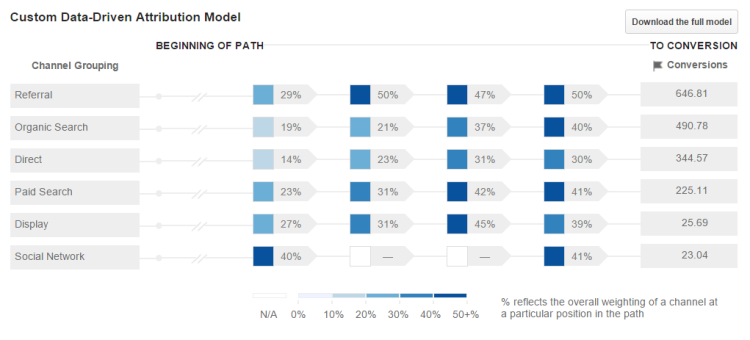
Some of the benefits to using the data-driven attribution include:
- Pretty quick and easy to implement
- Values all steps in conversion path
- Works with automated bidding ( as do the other attribution model options )
- Even works on very short conversion paths
Ultimately the choice of models is up to you, and there are some instances where you may find another optimal attribution model for your account. If you a large enough brand with enough traffic and data in your account’s history to qualify, the DDA can be a great solution.
Conclusion: A data-driven model takes the guesswork out of what model works best for you, but requires a larger number of conversions to work.
Consider Using a Rules-Based Model if You don’t Qualify for Data-Driven Attribution
Tip: You can use an Adwords manager account, and then use cross-account conversion tracking to combine your reported conversions. Analyzing more data can lead to better insights.

- Reach customers earlier in the purchase cycle: Find opportunities to influence customers earlier on their path to conversion.
- Match to your business: Use a model that works best for how people search for what you offer.
- Improve your bidding: Optimize your bids based on a better understanding of how your ads perform.
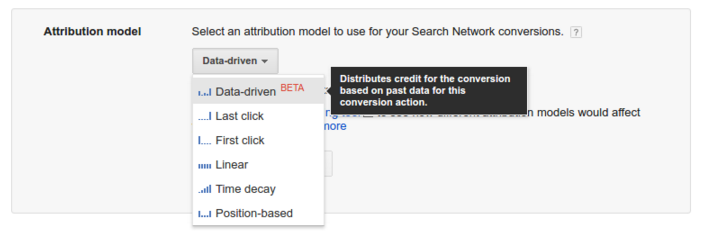
| Model | Description | Growth strategy | |
| Last-click (DEFAULT) | Gives all credit for the conversion to the last-clicked keyword | Most conservative | |
| First click | Gives all credit for the conversion to the first-clicked keyword | Most growth-oriented | |
| Linear | Distributes the credit for the conversion equally across all clicks on the path | Moderate | |
| Time decay | Gives more credit to clicks that happened closer in time to the conversion | Conservative | |
| Position-based | Gives 40% of credit to both the first- and last-clicked keyword, with the remaining 20% spread out across the other clicks on the path | Growth-oriented | |
| Data-driven | Gives credit to clicked keywords based on how imperative they were in the conversion process | Based on account’s performance |
The approach that you choose is going to determine the relationship you, your Adwords account and finally your customer’s path to purchase. Attribution is about putting the performance of different keywords and types ads into the proper perspective. Performance that seemed typical under pre-existing last click models could be dramatically different when you evaluate those keyword campaigns with a new model.
As a general rule, Keywords phrases that are clicked earlier in the conversion path (often generic terms ) tend to behave differently that keyword queries later down the conversion path ( like branded terms ).
| Early influence keywords | Late influence keywords | |
| Typical CPC | High | Low |
| Typical CTR | Low | High |
| Types of keywords | Generic
(“Luxury RV Resorts in Florida”) |
Branded
(“Silver Palms Luxury RV Resort in Florida”) |
The first click, can be considered a more aggressive model, since it shifts the performance stats to reward keyword ads earlier in the click path, while the more conservative model, like the last click, rewards or assigns credit to the keyword ads that occur later in the users’ click path to a conversion. As you evaluate and update the model you end up trying, it also makes sense to re-examine the performance goals you have for your Adwords account. Many advertisers see better performance with lower costs-per-acquisition for keywords earlier in the click path once they move to a more aggressive model, like the first click, will shift performance stats to reward keywords earlier in the click path, while a more conservative model, like the last click, will reward keywords that occur later in the click path. As you update the model you use, it might also make sense to re-evaluate the performance goals you have for your account. Many advertisers see better performance with lower cost-per-acquisition (CPA) keyword targeted ads that are in the upper funnel or earlier in the user click path once they move to a more aggressive attributional model, such as the first-click. If this is the case for your brand, consider increasing bids to get more volume at your previous CPA.
Here is a caveat to keep in mind, in the first few days or weeks after switching away from a last click model;
- Your costs will probably be the same but your conversions may show a small temporary drop
- Because the conversion lag for non-last-click models tends to be higher than for last-click models
- This may give you the impression for a short period of time, that your account’s performance is getting worse
- Things should stabilize or even out as your account adjusts to new ways of counting conversions
- Just realize that slight performance drops are expected and normal after you change attribution models
Tip: When you are reviewing your Adwords performance account data, it’s a good idea to choose an appropriate conversion history window. Why, because if you update your history window, you might end up seeing additional conversions that originated from clicks that fall outside of your current date range. So while your cost data will remain consistent (as it’s aligned with the date range you select), you may see may see more conversions appearing as you extent your history window.
Conclusion: Your attribution model should align with your business strategy.
3) Acting on attribution
Our PPC Adwords Attribution modeling guide helps companies to learn how to assign the suitable value to their keyword targeted ads and then take specific actions in their Adwords account with the purpose of meeting their customers’ search intent and driving more sales. Choosing the appropriate attribution model is only the first step in the process.
Bid to Your Chosen Attribution Model
In your Adwords account, once you have updated your attribution model, your conversion columns will update with stats that reflect your choice. From there it is fairly straightforward – you can optimize your bids to account for the numbers in those conversion columns. And by updating the conversion reporting, you make it easier to gauge performance and set the appropriate bids.
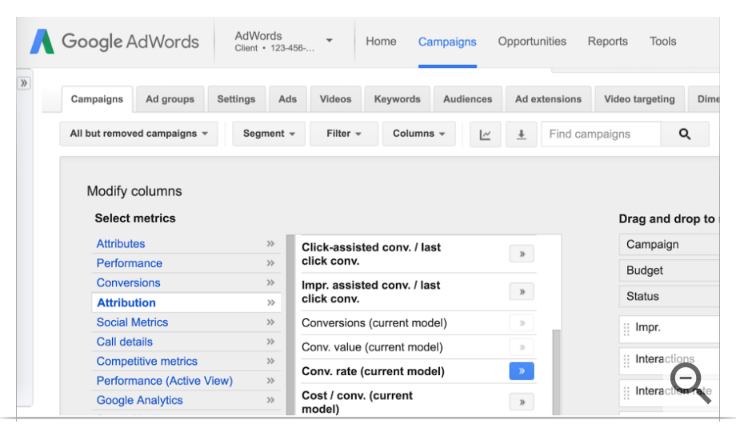
As you are evaluating performance under a new attribution model, it’s not recommended to review results on a campaign-by-campaign basis. Your keyword and account level performance numbers are supposed to change, as you are changing the way you assign the credit on ads leading to converting customers. Instead what you be looking at, is whether or not your entire account is growing.
Conclusion: Your attribution model will give you a truer sense of the value of a keyword. That value should be used when setting bids.
Testing your New Attribution Model
By now your brand has probably explored the different types of attribution models and made some decision of which ones you want to test. But before you commit to any model, though, you should want to test whether the results will match your expectations
As you prepare to test, it is recommended to identify your conversion time lag. It is the number of days between the first click and final conversion. It’ll tell you which time periods to exclude when you are analyzing the results of your new attribution modeling
test. The secret sauce of to proper testing is by minimizing the amount of changes you make. Patience is also important as you gather insights.
Testing the incrementality of an attribution model change. Remember – that you are now updating the way you count conversions, so here are list of steps to be followed across all campaigns that are using the conversion you are updating:
- Change your conversion type to your new attribution model. In your AdWords performance reports, add the “Current model” columns which match the new model you selected. This will show you your historical data as if you had been using that new model all along.
- Establish a control period. Examine ~ maybe 2 weeks of historical performance with the new attribution model, excluding your time lag from any analysis.
- Update your bids based on your new attribution model. This is a crucial step in testing and evaluating your new model’s performance. For your test period, you want to set a target Cost-Per-Acquisition (CPA) which is equal to the CPA you saw in the control period according to the new model. Otherwise, you risk conflating the attribution model change with bid changes, making it difficult to evaluate the achieved results.
- Establish a test period after your updated campaigns have run for 1-2 weeks with minimal changes. This 1-2 week period is to allow your account to adjust to the new model. Once performance stabilizes, let the new attribution model run for ~2 more weeks.
- Measure your tests based on both volume and efficiency for all of your campaigns affected by the change. Once your test period ends, wait for your time lag to elapse. This will give you the complete picture of your conversions. Then, compare your test period to your control period. You do this by comparing 2 columns for the test period vs. the control period: the “Conversions (Current model)” and “Cost-per-conversion (Current model)” columns.
So now if you are satisfied with the performance of your new attribution model, you can keep it running. When you are comparing the test period with the control period, more conversions at a similar or lower CPA is the result you are aiming to achieve. So if in fact you are seeing those results, you can now consider updating other conversion types to your new attribution model as well. If you are not happy with the performance of your new attribution model, you can always go back to a previous model or try out a new one entirely.
Conclusion: Before you commit to your new attribution model, test whether it delivers a higher volume of profitable conversions.
4) Changing your ads and landing pages to align with a customer’s place in the click path
Once you have identified the search intent of a keyword in the user journey, you then can modify your ads and landing pages to start a more mutually beneficial conversion. A set of keywords that tend to be the early stage or user’s click path could benefit from a less direct or more educational landing page. You could think of these landing pages as inspirational landing pages instead of the typical late stage “buy right now” transactional page.

Conclusion: If certain keywords tend to assist, rather than complete, conversions, your creatives and landing pages should take that insight into account.
Go back and now take another look at the early influence keywords based on your new attribution model
As many brands start to try and implement new attribution models, they may think not much is changing. There are obviously places to make improvements and get more success, but there is far less change anticipated.
In circumstances such as these, it’s recommended to go and re-evaluate early funnel or influence keyword queries that you might have cut or deleted from your Adwords account. As you are experimenting a new way of attributing conversions in Adwords, you should also plan on testing (or retesting) early awareness stage keywords. Try experimenting with keywords that may have seemed too broad in the past – you may just find that they can be very good at conversation, but not so great at finishing the conversion.
If you now changing the way you look at the complete customer journey across all channels, and the way are defining success, new keywords could have a better chance at being successful. The performance of those keywords won’t different than it was in the past. What will be different, though is how you now define and measure success. You should see their new, and true value.
Conclusion: Many keywords provide value that last-click attribution doesn’t properly capture, including early influence keywords you may have paused in the past.
5) Evolve your approach to attribution as measurement gets better

Take aways: What you learn about AdWords clicks, in conjunction with insights from other tools like Google Analytics and Attribution 360, can improve your approach in other marketing channels.
- Get clarity across all marketing channels: Compare performance to correct both over- and under-spending.
- Connecting marketing metrics:
- back to valuable business outcomes is the key to driving business success with your attribution program.
- Identify best and worst performing ads: to ensure that the best creative, messaging, sequencing, targeting and placements are in the media plan.
- Define what a conversion is: If you are doing any website optimization, you have probably already thought about how to guide consumers to specific actions on your site. Whether it’s a sale, a content download, or a lead form submission, define what digital conversions you will “attribute” towards.
Conclusion
This may seem complex, but with getting a handle on your customer journey and attribution insights, you can identify wasteful spend and profitable tactics, previously hidden by last click reporting. Use the insights to shift spend and adjust tactics accordingly.


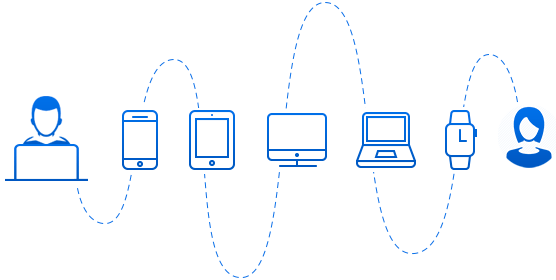
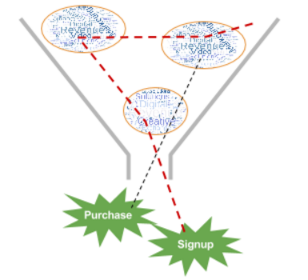 How the Data-Driven Attribution (DDA) Methodology Works
How the Data-Driven Attribution (DDA) Methodology Works 


One Response